Study on the Shape Characteristics and the Allometry of Phalaenopsis Leaves for Greenhouse Management
Abstract
1. Introduction
2. Results
2.1. The Leaf Specification
2.1.1. The Ratio Characteristics
2.1.2. The Ratio Characteristics of Five Varieties
2.2. The Prediction Performance for the Total Leaf Area
3. Discussion
4. Materials and Methods
4.1. The Total Leaf Area Model
4.2. Testing Materials
4.3. Measurement of Leaf Characteristics
4.4. Data Analysis
4.5. Model Evaluation
5. Conclusions
Author Contributions
Funding
Data Availability Statement
Acknowledgments
Conflicts of Interest
References
- Paradiso, R.; De Pascale, S. Effects of plant size, temperature, and light intensity on flowering of Phalaenopsis hybrids in Mediterranean greenhouses. Sci. World J. 2014, 2014, 420807. [Google Scholar] [CrossRef] [PubMed]
- Chen, C. The Fundamental issue in the Phalaenopsis industry in the Netherlands. J. Agric. For. 2020, 67, 89–100. [Google Scholar]
- Anthura, B.V.; Bureau, I.M.A.C.; Bleiswijk, B.V. Cultivation Guide Phalaenopsis: Knowledge for Professionals; Anthura: Bleiswijk, The Netherlands, 2005. [Google Scholar]
- Hew, C.S.; Yong, J.W. Physiology of Tropical Orchids in Relation to the Industry; The World Scientific Publishing Company: Singapore, 2004. [Google Scholar]
- Lemaire, G.; Sinclair, T.; Sadras, V.; Bélanger, G. Allometric approach to crop nutrition and implications for crop diagnosis and phenotyping. A review. Agron. Sustain. Dev. 2019, 39, 27. [Google Scholar] [CrossRef]
- Shi, P.; Niinemets, Ü.; Hui, C.; Niklas, K.J.; Yu, X.; Hölscher, D. Leaf bilateral symmetry and the scaling of the perimeter vs. the surface area in 15 vine species. Forests 2020, 11, 246. [Google Scholar] [CrossRef]
- Fanourakis, D.; Kazakos, F.; Nektarios, P.A. Allometric individual leaf area estimation in chrysanthemum. Agronomy 2021, 11, 795. [Google Scholar] [CrossRef]
- Colchado-López, J.; Cervantes, R.C.; Rosas, U. A linear model to describe branching and allometry in root architecture. Plants 2019, 8, 218. [Google Scholar] [CrossRef]
- Feng, J.Q.; Zhang, F.P.; Huang, J.L.; Hu, H.; Zhang, S.B. Allometry between vegetative and reproductive traits in orchids. Front. Plant Sci. 2021, 12, 728843. [Google Scholar] [CrossRef]
- Mantovani, A. Size dependent allocation to vegetative and reproductive organs of the orchid Lankesterella ceracifolia (Spiranthinae). Lankesteriana Int. J. Orchidol. 2022, 22, 225–240. [Google Scholar] [CrossRef]
- Lawless, C.; Semenov, M.A.; Jamieson, P.D. A wheat canopy model linking leaf area and phenology. Eur. J. Agron. 2005, 22, 19–32. [Google Scholar] [CrossRef]
- Lee, H.B.; Jeong, S.J.; Lim, N.H.; An, S.K.; Kim, K.S. Correlation between carbohydrate contents in the leaves and inflorescence initiation in Phalaenopsis. Sci. Hortic. 2020, 265, 109270. [Google Scholar] [CrossRef]
- Chen, C.; Lin, R.S. CO2 Uptake patterns in Phalaenopsis amabilis. Afr. J. Agric. Res. 2012, 7, 128–141. [Google Scholar]
- Li, Z.; Ji, C.; Liu, J. Leaf area calculating based on digital image. In International Conference on Computer and Computing Technologies in Agriculture; Springer: Boston, MA, USA, 2007; pp. 1427–1433. [Google Scholar]
- Faust, J.E.; Heins, R.D. Modeling leaf development of the African violet (Saintpaulia ionantha Wendl.). J. Am. Soc. Hortic. 1993, 118, 747–751. [Google Scholar] [CrossRef]
- Okie, J.G. General models for the spectra of surface area scaling strategies of cells and organisms: Fractality, geometric dissimilitude, and internalization. Am. Nat. 2013, 181, 421–439. [Google Scholar] [CrossRef]
- Smith, D.D.; Sperry, J.; Adler, F.R. Convergence in leaf size versus twig leaf area scaling: Do plants optimize leaf area partitioning? Ann. Bot. 2017, 119, 447–456. [Google Scholar] [CrossRef]
- Schrader, J.; Shi, P.; Royer, D.L.; Peppe, D.J.; Gallagher, R.V.; Li, Y.; Wright, I.J. Leaf size estimation based on leaf length, width and shape. Ann. Bot. 2021, 128, 395–406. [Google Scholar] [CrossRef]
- Koyama, K.; Smith, D.D. Scaling the leaf length-times-width equation to predict total leaf area of shoots. Ann. Bot. 2022, 130, 215–230. [Google Scholar] [CrossRef]
- Swart, E.D.; Groenwold, R.; Kanne, H.J.; Stam, P.; Marcelis, L.F.; Voorrips, R.E. Non-destructive estimation of leaf area for different plant ages and accessions of Capsicum annuum L. J. Hortic. Sci. Biotechnol. 2004, 79, 764–770. [Google Scholar] [CrossRef]
- Shi, P.; Liu, M.; Yu, X.; Gielis, J.; Ratkowsky, D.A. Proportional relationship between leaf area and the product of leaf length and width of four types of special leaf shapes. Forests 2019, 10, 178. [Google Scholar] [CrossRef]
- He, J.; Reddy, G.V.; Liu, M.; Shi, P. A general formula for calculating surface area of the similarly shaped leaves: Evidence from six Magnoliaceae species. Glob. Ecol. Conserv. 2020, 23, e01129. [Google Scholar] [CrossRef]
- Mazzini, R.B.; Ribeiro, R.V.; Pio, R.M. A simple and non-destructive model for individual leaf area estimation in citrus. Fruits 2010, 65, 269–275. [Google Scholar] [CrossRef]
- Yu, X.; Shi, P.; Schrader, J.; Niklas, K.J. Nondestructive estimation of leaf area for 15 species of vines with different leaf shapes. Am. J. Bot. 2020, 107, 1481–1490. [Google Scholar] [CrossRef]
- Chen, C.; Lin, R.S. Nondestructive estimation of dry-weight and leaf area of Phalaenopsis leaves. Appl. Eng. Agric. 2004, 20, 467–472. [Google Scholar] [CrossRef]
- Ogawa, K.; Furukawa, A.; Hagihara, A.; Abdullah, A.M.; Awang, M. Morphological and phenological characteristics of leaf development of Durio zibethinus Murray (Bombacaceae). J. Plant Res. 1995, 108, 511–515. [Google Scholar] [CrossRef]
- Sun, J.; Wang, M.; Lyu, M.; Niklas, K.J.; Zhong, Q.; Li, M.; Cheng, D. Stem and leaf growth rates define the leaf size vs. number trade-off. AoB Plants 2019, 11, plz063. [Google Scholar] [CrossRef]
- Sun, J.; Wang, M.; Lyu, M.; Niklas, K.J.; Zhong, Q.; Li, M.; Cheng, D. Stem diameter (and not length) limits twig leaf biomass. Front. Plant Sci. 2019, 10, 185. [Google Scholar] [CrossRef]
- Koyama, K.; Hidaka, Y.; Ushio, M. Dynamic scaling in the growth of a non-branching plant, Cardiocrinum cordatum. PLoS ONE 2012, 7, e45317. [Google Scholar] [CrossRef]
- Teobaldelli, M.; Rouphael, Y.; Gonnella, M.; Buttaro, D.; Rivera, C.M.; Muganu, M.; Basile, B. Developing a fast and accurate model to estimate allometrically the total shoot leaf area in grapevines. Sci. Hortic. 2020, 259, 108794. [Google Scholar] [CrossRef]
- Lopes, C.; Pinto, P. Easy and accurate estimation of grapevine leaf area with simple mathematical models. Vitis 2005, 44, 55–61. [Google Scholar]
- Liao, M.S.; Chen, S.F.; Chou, C.Y.; Chen, H.Y.; Yeh, S.H.; Chang, Y.C.; Jiang, J.A. On precisely relating the growth of Phalaenopsis leaves to greenhouse environmental factors by using an IoT-based monitoring system. Comput. Electron. Agric. 2017, 136, 125–139. [Google Scholar] [CrossRef]
- Gary, C.; Jones, J.W.; Tchamitchian, M. Crop modelling in horticulture: State of the art. Sci. Hortic. 1998, 74, 3–20. [Google Scholar] [CrossRef]
- Thornley, J.H.; Johnson, I.R. Plant and Crop Modelling; Clarendon: Oxford, UK, 1990. [Google Scholar]
- van Tongerlo, E.; van Ieperen, W.; Dieleman, J.A.; Marcelis, L.F.M. Vegetative traits can predict flowering quality in Phalaenopsis orchids despite large genotypic variation in response to light and temperature. PLoS ONE 2021, 6, e0251405. [Google Scholar] [CrossRef] [PubMed]
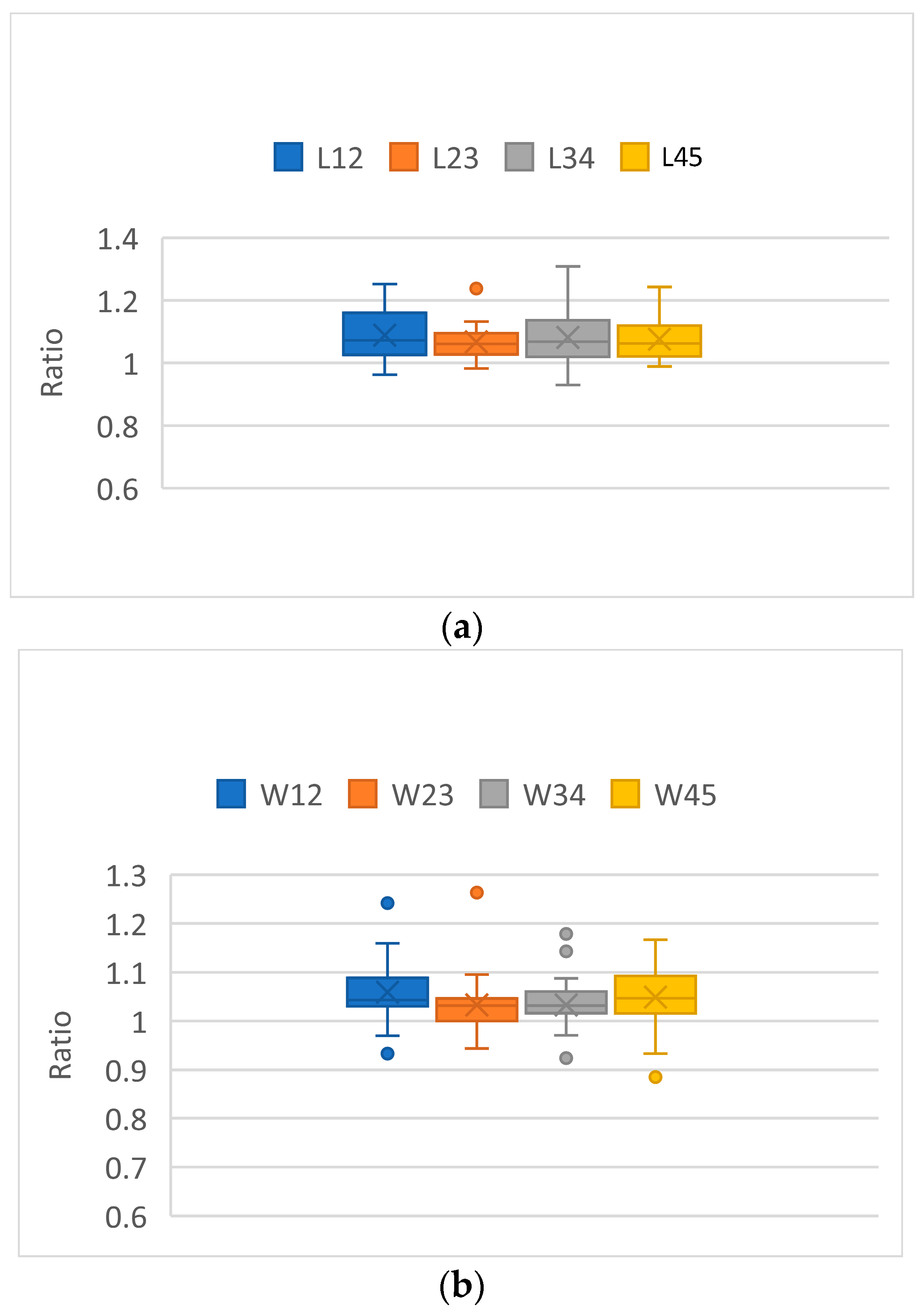
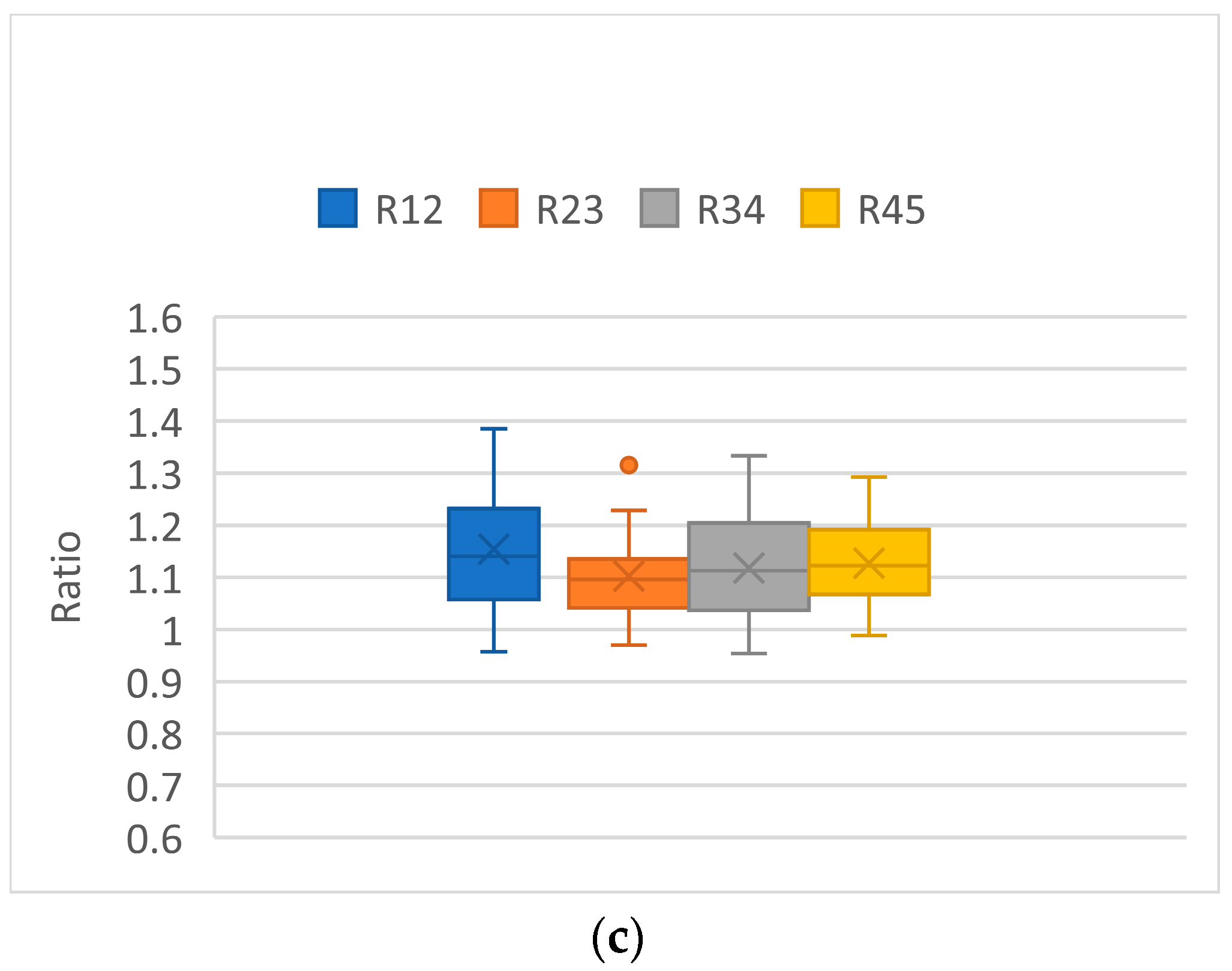
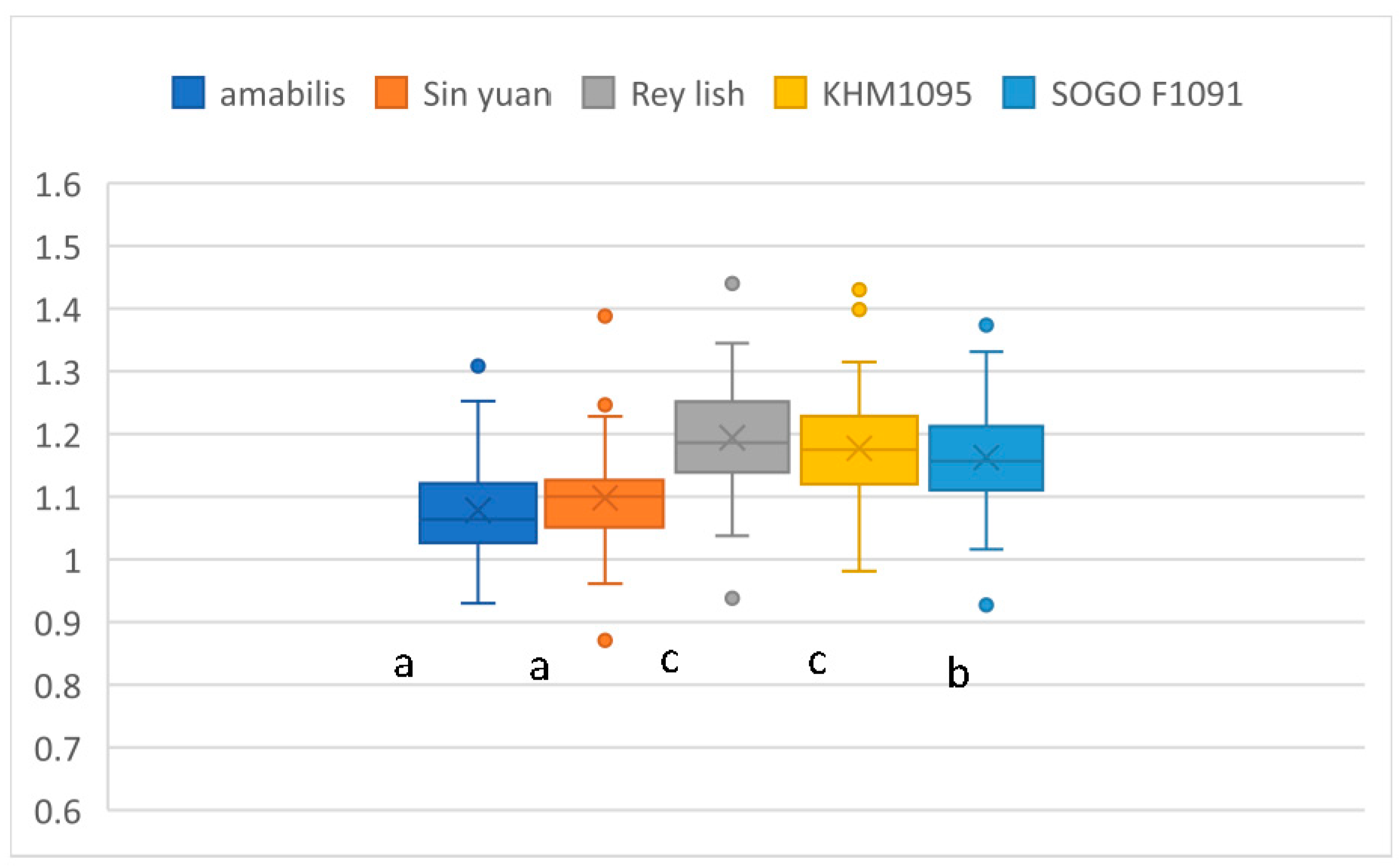
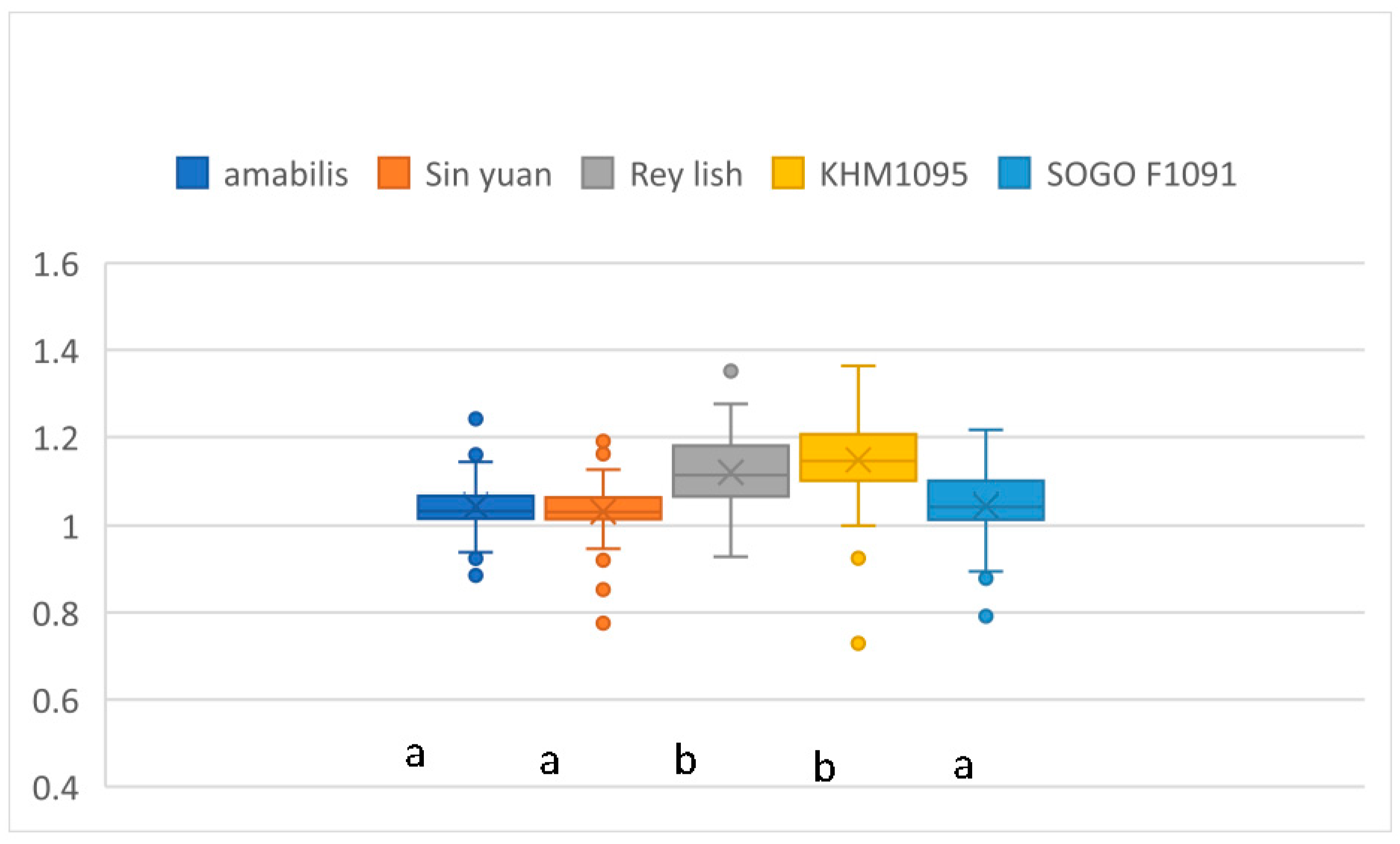
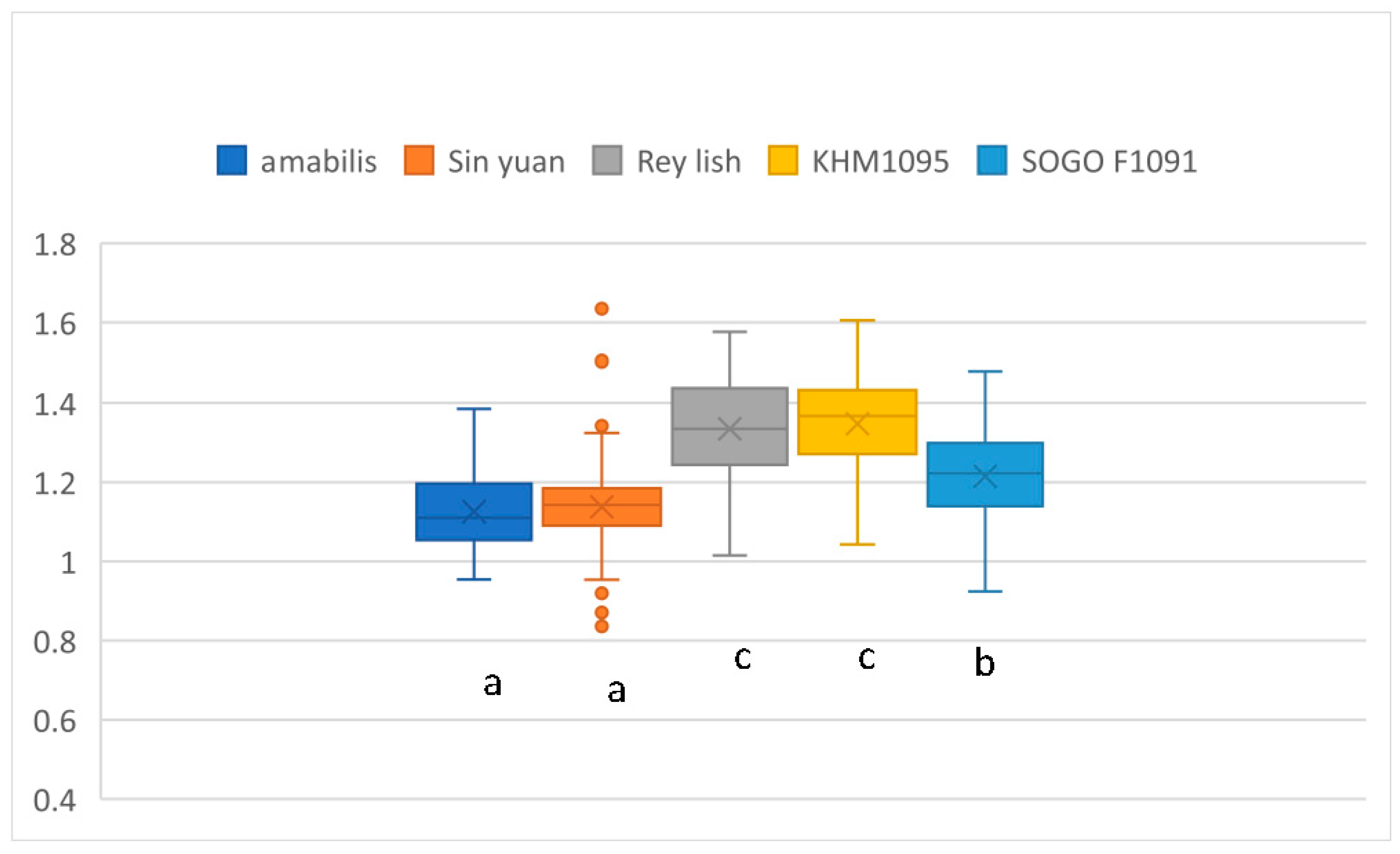

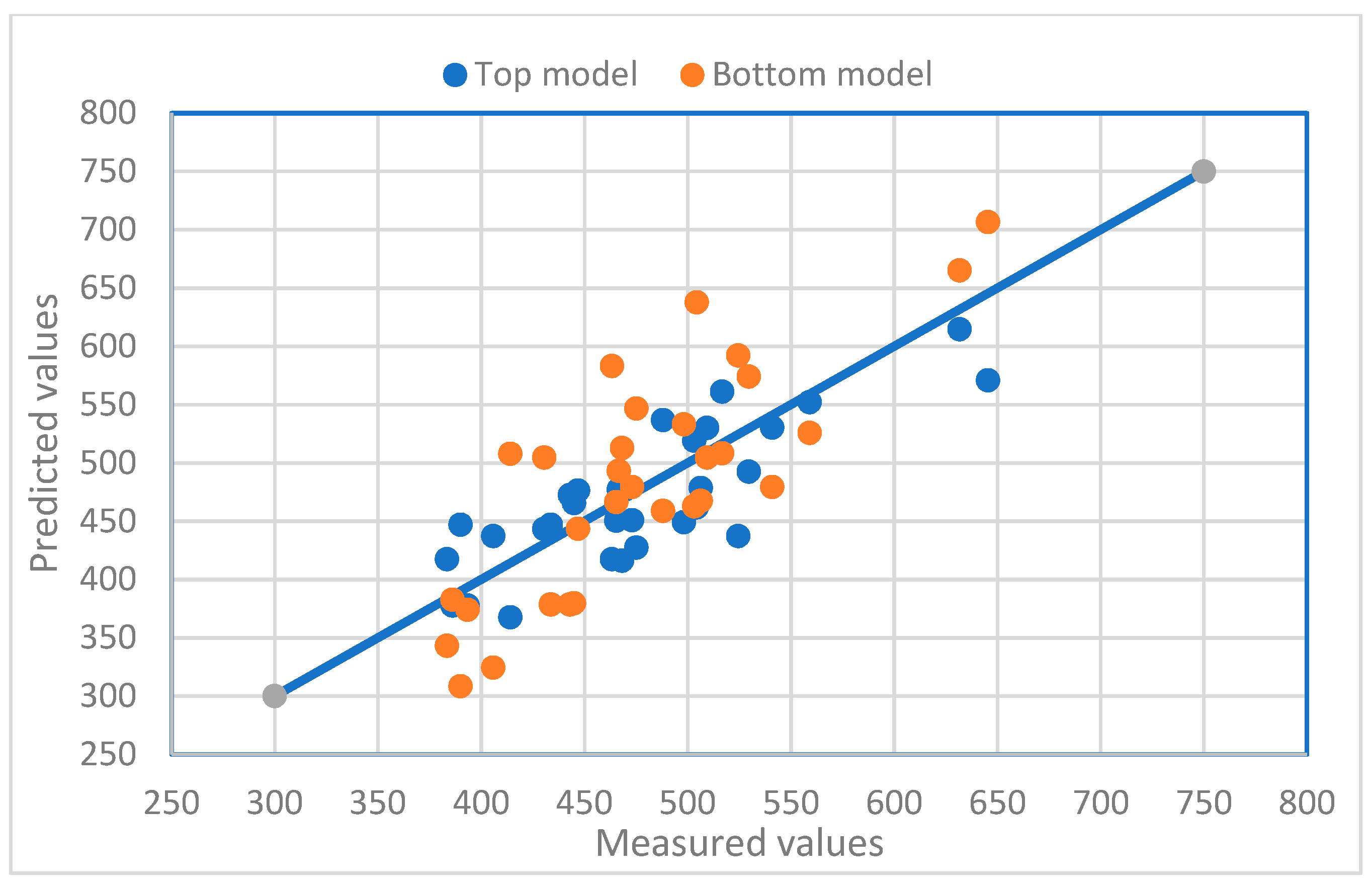

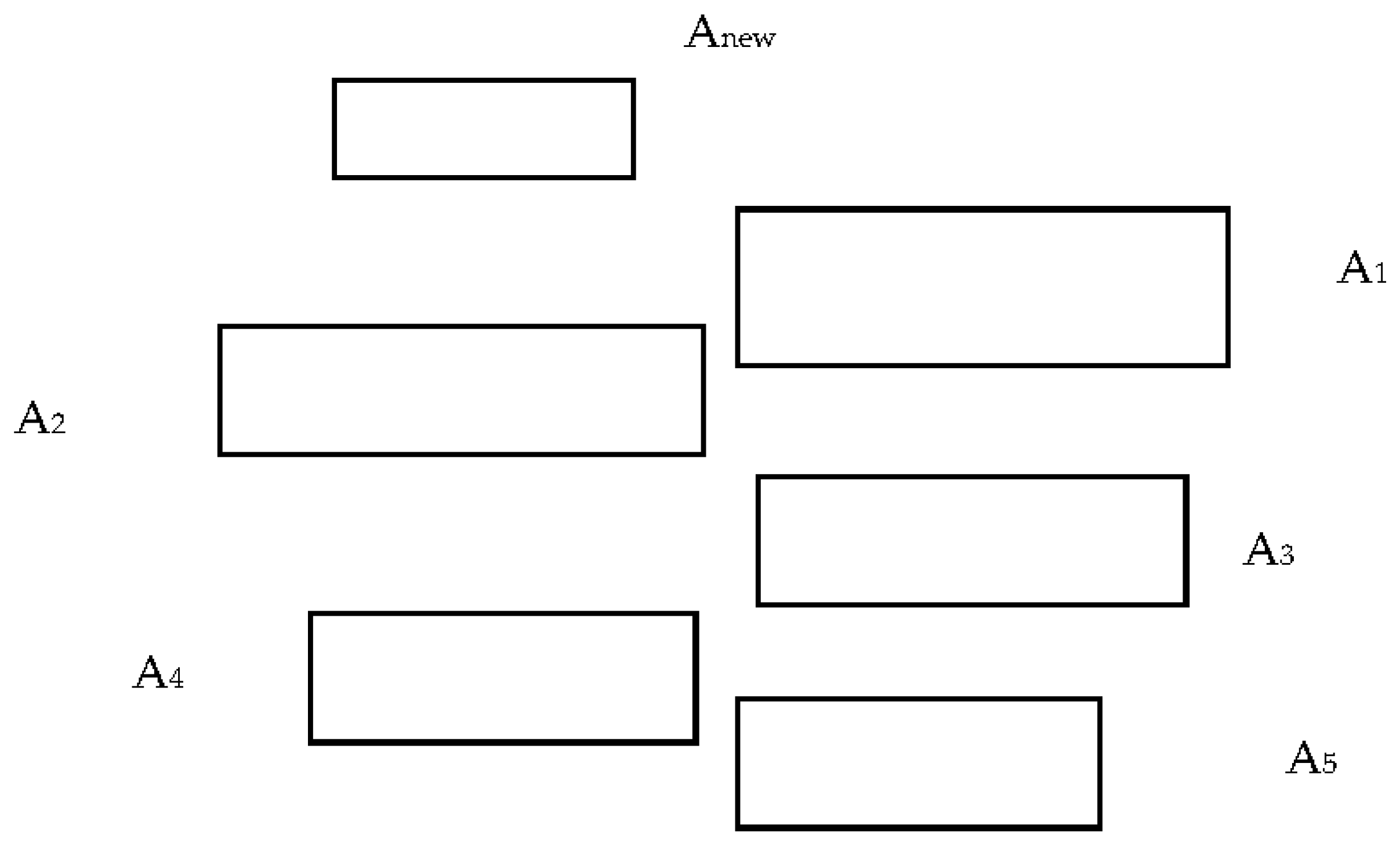
| Amabilis | Sin Yuan | Rey Lish | KHM1095 | Sogo F1091 | |
|---|---|---|---|---|---|
| Mean | 265.34 | 414.56 | 478.04 | 577.61 | 419.82 |
| S.D. | 4.11 | 7.72 | 11.84 | 13.06 | 6.86 |
| Minimum | 222.59 | 329.52 | 383.42 | 429.15 | 325.41 |
| Maximum | 333.85 | 478.73 | 645.53 | 734.36 | 528.95 |
| Amabilis | Sin Yuan | Rey Lish | KHM 1095 | Sogo F1091 | |
|---|---|---|---|---|---|
| Top model | |||||
| −39.68 | −98.01 | −87.22 | −66.3 | −64.47 | |
| 35.07 | 35.18 | 57.05 | 37.54 | 68.84 | |
| ave | 19.15 | 23.33 | 32.48 | 22.25 | 30.79 |
| Bottom model | |||||
| −50.74 | −128.1 | −81.52 | −107.05 | −71.15 | |
| 55.44 | 65.5 | 133.51 | 106.68 | 102.71 | |
| ave | 21.13 | 24.19 | 48.15 | 45.94 | 32.91 |
| Amabilis | Sin Yuan | Rey Lish | KHM 1095 | Sogo F1091 | ||
|---|---|---|---|---|---|---|
| N = 10 | Area | 277.92 (100%) | 415.97 | 505.51 | 569.62 | 419.03 |
| Top model | 292.99 (5.4%) | 421.38 (1.3%) | 474.93 (−5.9%) | 540.69 (−5.1%) | 402.80 (−4.0%) | |
| Bottom model | 269.88 (−2.9%) | 405.15 (−2.6%) | 524.2 (3.7%) | 607.53 (6.7%) | 428.74 (2.3%) | |
| N = 20 | Area | 274.83 (100%) | 414.56 | 480.20 | 574.14 | 410.77 |
| Top model | 279.83 (1.8%) | 417.88 (0.8%) | 470.80 (−1.9%) | 559.17 (−2.6%) | 404.40 (−1.6%) | |
| Bottom model | 270.08 (−1.7%) | 407.10 (−1.8%) | 483.13 (0.6%) | 583.95 (1.7%) | 414.5 (0.9%) | |
| N = 30 | Area | 265.34 (100%) | 413.14 | 478.04 | 577.60 | 419.82 |
| Top model | 260.61 (0.4%) | 411.95 (−0.3%) | 470.08 (−1.7%) | 582.33 (0.8%) | 414.60 (−1.2%) | |
| Bottom model | 269.94 (1.7%) | 409.66 (−0.8%) | 484.10 (1.3%) | 570.93 (−1.1%) | 424.14 (1.0%) |
| Amabilis | Sin Yuan | Rey Lish | KHM1095 | Sogo F-1091 | |
|---|---|---|---|---|---|
| Plant height (cm) | 40 | 50 | 70 | 70 | 40 |
| Flower size (cm) | 4.5 | 7.5 | 10.5 | 10.0 | 4.5 |
| Flower color | White | Yellow with red lip | Red | Red | Pink |
Disclaimer/Publisher’s Note: The statements, opinions and data contained in all publications are solely those of the individual author(s) and contributor(s) and not of MDPI and/or the editor(s). MDPI and/or the editor(s) disclaim responsibility for any injury to people or property resulting from any ideas, methods, instructions or products referred to in the content. |
© 2023 by the authors. Licensee MDPI, Basel, Switzerland. This article is an open access article distributed under the terms and conditions of the Creative Commons Attribution (CC BY) license (https://creativecommons.org/licenses/by/4.0/).
Share and Cite
Chen, J.; Chen, C. Study on the Shape Characteristics and the Allometry of Phalaenopsis Leaves for Greenhouse Management. Plants 2023, 12, 2031. https://doi.org/10.3390/plants12102031
Chen J, Chen C. Study on the Shape Characteristics and the Allometry of Phalaenopsis Leaves for Greenhouse Management. Plants. 2023; 12(10):2031. https://doi.org/10.3390/plants12102031
Chicago/Turabian StyleChen, Jiunyuan, and Chiachung Chen. 2023. "Study on the Shape Characteristics and the Allometry of Phalaenopsis Leaves for Greenhouse Management" Plants 12, no. 10: 2031. https://doi.org/10.3390/plants12102031
APA StyleChen, J., & Chen, C. (2023). Study on the Shape Characteristics and the Allometry of Phalaenopsis Leaves for Greenhouse Management. Plants, 12(10), 2031. https://doi.org/10.3390/plants12102031






